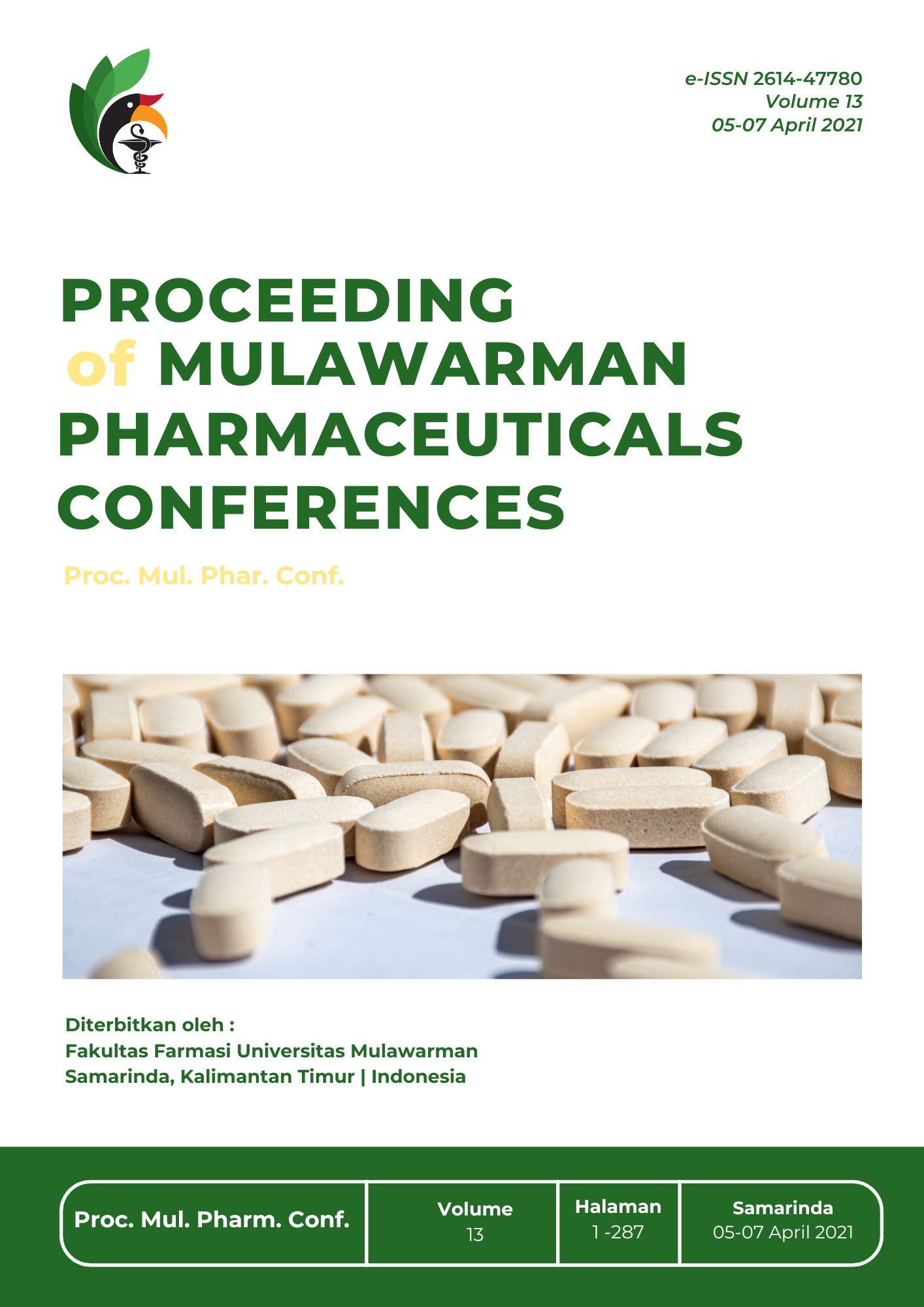Antioxidant Analysis of Kokang Leaves (Lepisanthes amoena) Using DPPH Method
DOI:
https://doi.org/10.30872/mpc.v13i.339Keywords:
Antioxidants, Lepisanthes Amoena, kokang leaves, DPPHAbstract
Kokang Leaf (Lepisanthes amoena) as a traditional cosmetic for the Dayak Benuaq and Tunjung tribe is very important to be developed in medicine because it is contain secondary metabolites as antioxidants. This research was conducted with the aim of knowing the yield of kokang leaves (Lepisanthes amoena), the profile of TLC, and knowing the fraction with the greatest antioxidants in kokang leaves (Lepisanthes amoena). The research used DPPH, KLT, and yield calculation method. The yield obtained in ethanol extract 96% = 23%; N-Hexan = 9.448%; Ethyl Acetate = 1.37%; Ethanol 70% = 9.95%. TLC test results using N.Hexan : Ethyl Acetate (2: 1) eluent and then sprayed with 10% H2SO4, in 96% ethanol extract there were 7 stains, N-Hexan Fraction 9 stains, Ethyl Acetate Fraction 5 stains, and Ethanol Fraction 70 % 1 stain. The qualitative test results after spraying DPPH on TLC, there were yellow spots on a purple background indicating antioxidant activity. The IC50 results were obtained in 96% Ethanol Extract 6.8171 ppm, N-Hexan Fraction 10.0184 ppm, Ethyl Acetate Fraction 5.0107 ppm, and Ethanol 70% Fraction 24.7343 ppm. Based on the results above, it can be concluded that the ethyl acetate extract has the highest antioxidant activity with 5.0107 ppm being able to inhibit DPPH radicals.
References
[1] Andriani Y, Wahid MEA Muhammad TST and Mohamad H, January 2011, Antibacterial, Radical ? Scavenging Activities and Cytotoxicity Properties of Phaleria macrocarpa (Scheff.) Boerl leaves In HEPG2 Cell Lines. International Journal of Pharmaceutical Science and Research, Voume 2, Issue 7 ISSN: 0975-8232.
[2] Arifin b., 2018, ?Struktur, Bioaktivitas Dan Antioksidan Flavonoid?. Jurnal Zarah, 6(1), 21-29.
[3] Batubara, I. and Mitsunaga, T, 2013, ?Use of Indonesian Medicinal Plants Products Against Acne?. Reviews in Agricultural Science, 1(0), 11?30.
[4] FJ Sami, siti rahimah, (2015). ?Uji Aktivitas Antioksidan Ekstrak Metanol Bunga Brokoli (Brassica oleracea L. Var. Italica) Dengan Metode DPPH (2,2 Diphenyl-1-Picrylhydrazyl) Dan Metode ABTS (2,2 Azinobis (3-Etilbenzotiazolin)-6-Asam Sulfonat).? Jurnal Fitofarmaka Indonesia (JFFI). 2(2), 107-110
[5] Haeria, Sukri, Muhammad Rusdi.2016.?fraksinasi dan Identifikasi Senyawa Ekstrak n-heksan Klika Anak Dara (Croton oblongus Burm F.)?. Majalah Farmasi, Sains, dan Kesehatan Pharmauho 2(1), 13-16.
[6] Henny Hidayah, Rolan Rusli, Herman, M. A. M., 2013, ?Potensi Ekstrak Daun Kokang (Lepisanthes amoena (Haask) Leenh) Sebagai Obat Luka?. Journal of Chemical Information and Modeling, 53(9), 1689?1699.
[7] Herman, 2013, ?Aktivitas Antioksidan Beberapa Tumbuhan Obat Kalimantan Timur?. J. Trop. Pharm. Chem., 2(2), 100-10.
[8] Molyneux, P. 2004. The Use of The Stable Free Radical Diphenylpicrylhydrazyl (DPPH) for Estimating Antioxidant Activity. Songklanakarin: Journal of Science and Technology.
[9] Rijai, L., 2012, ?Beberapa Tumbuhan Obat Asal Kalimantan Timur Sebagai Sumber Saponin Potensial?. Journal Of Tropical Pharmacy And Chemistry, 1(4),301?306.
[10] Safrina D.H, Sri P., Ekowati H., 2014, ?Aktivitas Antioksidan Dan Efek Hepatoprotektif Daun Bakau Api-Api Putih?. Jurnal Pengolahan Hasil Perikanan Indonesia, 17(1), 80-91.
[11] Salusu, H. D., Ariani, F., Obeth, E., Rayment, M., Budiarso, E., Kusuma, I. W., & Arung, E. T., 2017, ?Phytochemical Screening and Antioxidant Activity of Kokang (Lepisanthes amoena) Fruit. Agrivita?. Journal of Agricultural Science, 39(2), 214-218.
[12] Senja, Yulia Rima, dkk. 2014.? Perbandingan Metode Ekstraksi dan Variasi Pelarut Terhadap Rendemen dan Aktivitas antioksidan Ekstrak Kubis Ungu (Brassica oleracea L var. capitata f. Rubra).? Journal of Faculty Of Pharmacy Univesitas Gadjah Mada, Vol 19 (1), 43-48.
[13] Tiwari, p., Kumar, B., Kaur, M., Kaur, G., Kaur, H. 2011. Phyrochemical screening and extraction: A Review. Internationale Pharmaceutica scencia., Vol.1 (1): 98-106.
[14] Trusheva, B.,Trunkova, D., Bankova, V.2007. Different Extraction of Biologically active components from propolis; a Preliminary Study. In: Chemistry Central Journal of Biochemistry & Cell Biology, 39: 44-84.
Downloads
Published
Issue
Section
License
Copyright (c) 2021 Siti Anisah Nur Fajriyati, M Arifuddin, Hadi Kuncoro (Author)

This work is licensed under a Creative Commons Attribution-NonCommercial 4.0 International License.


